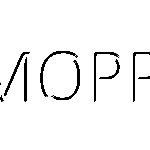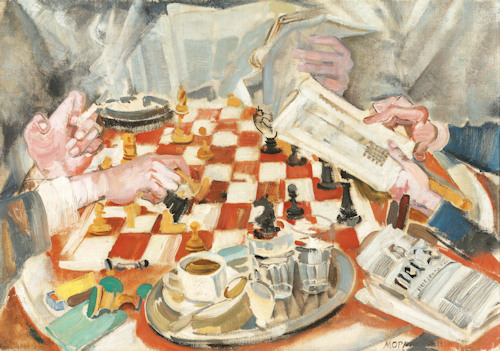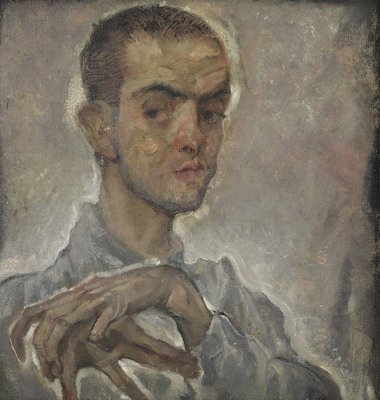
Mention Oppenheimer these days and thoughts turn to the father of the atomic bomb. But the Leopold Museum draws our attention to another same-named pioneer in a more peaceful field of endeavour: Max Oppenheimer and expressionist painting.
- Explores Oppenheimer’s oeuvre and motifs
- Also includes relationships to contemporaries like Schiele & Kokoschka
- 170+ exhibits
- Runs Oct 6, 2023 – Feb 25, 2024
- See also:
Expressionist Pioneer

(View of part of the exhibition; press photo © Leopold Museum, Vienna, 2023 | Photo by Lisa Rastl)
Earlier in 2023, Lower Belvedere had an exhibition of large-format works. The kind that might fill a wall or need you to unscrew the doors to get them into the gallery.
Many paintings left a lasting impression on me, including a remarkable work with the title The Philharmonic: Gustav Mahler conducts at its centre with the vibrancy of an orchestral piece brought to life in the musicians and instruments that surround the great composer.
Vienna-born Max Oppenheimer (1885 – 1954) began the painting in 1926 and completed it in 1952.
Despite the mastery of the brush and canvas visible in such pieces as The Philharmonic, Oppenheimer has not often enjoyed the recognition he deserves. The Leopold Museum makes up for this unwarranted oversight with the most comprehensive exhibition ever held around his works and motifs.

(Max Oppenheimer, The Chess Match, 1925/30 © Oesterreichische Nationalbank; photo: Sammlung Oesterreichische Nationalbank)
The full exhibition title of Max Oppenheimer. Expressionist Pioneer acknowledges his role as one of the groundbreaking artists of his time, even if history has cast a fog of neglect over his once strong reputation.
Oppenheimer, for example, exhibited at the legendary Kunstschau in 1908, where Klimt’s The Kiss first saw the light of day. Schiele was an admirer, and the Leopold Museum also places Oppenheimer in the context of his fellow contemporaries as they together pushed back the borders of art.
Schiele became a friend, as evidenced in reciprocal portraits of each by the other, and Oppenheimer even spent time working in Schiele’s studio.
A friendship with Oskar Kokoschka, however, proved less enduring, morphing into a rivalry and worse. Kokoschka even sought to exploit his international influence to bring Oppenheimer’s work into disrepute.

(Max Oppenheimer, String Quartet, c. 1941 © Oesterreichische Nationalbank; photo: Sammlung Oesterreichische Nationalbank)
The sections on Schiele and Kokoschka bring a narrative quality to the exhibition and breathe more life into the person of Oppenheimer than you get from the art alone.
Not long after the Kunstschau, Oppenheimer left the country for long periods in Berlin and Switzerland, only returning to Vienna in the early 1930s. In an all-too-common fate for artists with Jewish heritage, he was forced to flee Austria with the rise of the Nazis and eventually died in the US in poverty.
The exhibition presents numerous works from throughout Oppenheimer’s life, including the portraits and portrayals of musicians for which he is perhaps best known. (A nice bonus is a painting of Sigmund Freud without a beard!)
Those paintings of musicians playing their instruments ooze a furious dynamism, particularly those of various quartets where we see more or less only hands and instruments.

(Max Oppenheimer, Portrait of Egon Schiele, 1910 © Wien Museum; photo: Wien Museum / Birgit and Peter Kainz)
The chronological progression through Oppenheimer’s work left two impressions on me.
First, the art from the early 1900s has a certain fascination to it as Oppenheimer transitions into modernist genres. They take us back to a time when the borders between now-familiar styles had yet to become established.
Second, as with the concurrent Münter exhibition, you sense the powerful influence exerted on the artist through age and circumstance: from the ferocious creativity of youth in a world on the cusp of great change to the gentler “banality” produced as an older exile.
Dates, tickets & tips
Discover Oppenheimer’s pioneering art from October 6th, 2023 to February 25th, 2024. An entrance ticket from or for the Leopold Museum includes the special exhibitions.
As mentioned earlier, the Leopold Museum shines a light for much of the same time on another artist deserving of more appreciation, namely the multi-talented Gabriele Münter. And, of course, you also find the likes of Schiele and Kokoschka in the museum’s permanent Vienna 1900 exhibition.
How to get there
Follow the travel tips on the Leopold Museum main page. You should see the Oppenheimer exhibition on Level -1 (one floor below the entrance).
Address: MuseumsQuartier, Museumsplatz 1, 1070 Vienna